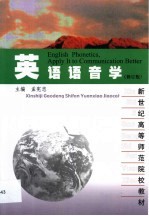

英语语音学PDF电子书下载
- 电子书积分:11 积分如何计算积分?
- 作 者:孟宪忠主编;崔希智等编写
- 出 版 社:上海:华东师范大学出版社
- 出版年份:1999
- ISBN:7561718683
- 页数:279 页
Part One Rhythm 1
Unit 1 Word stress 13
Ⅰ. Kinds of Stress(重音的种类) 13
Ⅱ. Stress Placement(重音位置) 14
Ⅲ. Stress Influence on Meaning of Words 18
Unit 2 Sentence Stress 23
Ⅰ. Sense Stress 23
Ⅱ. Logical Stress 28
Ⅲ. Emotional Stress 29
Ⅰ. Rhythm(节奏) 33
Ⅱ. Rhythm Group(节奏)and Its Division 33
Unit 3 Rhythm and Its features 33
Ⅲ. Features of English Rhythm(英语节奏的特点) 34
Unit 4 Rhythm Patterns 43
Unit 5 Sense-groups and Pausing 55
Ⅰ. Sense-groups and Their Divisions 55
Ⅱ. Pausing 57
Part two Intonation 65
Unit 6 A Brief Introduction 65
Ⅰ. Definition 65
Ⅱ. Function 65
Ⅲ. Illustrating Intonation 66
Unit 7 Basic Tones and Their Training 71
Ⅰ. Basic Tones(基本声调) 71
Ⅱ. Basic Training of Tones 73
Unit 8 Tone-groups 79
Ⅰ. Tone-groups(声调组) 79
Ⅱ. Tone-group Division 80
Ⅲ. Structure of the Tone-group(or Tune) 80
Prehead 81
Head 82
Body 83
Nucleus 83
Tail 84
Ⅳ. Features of an English Tune 85
Unit 9 function Of Tunes and Their Uses 91
Ⅰ.Falling Tune 91
Ⅱ.Rising Tune 94
Ⅲ.Falling-rising Tune 97
Unit 10 Combined Tunes 103
Ⅰ.Fall+Fall 103
Ⅱ.Fall+Rise 104
Ⅲ.Rise+Fall 105
Ⅳ.Fall+Rise 106
Ⅴ.Fall-Fall-rise 107
Ⅵ.Fall-rise+Fall 108
Ⅶ.fall-rise+Rise 108
Unit 11 Reading of Long Sentences 113
Ⅰ.Tune Broken Upwards ( Broken Tune or Accidental Rise ) 113
Ⅱ.Intonation of Vocatives 114
Ⅲ.Intonation of Parenthesis 115
Ⅳ.Intonation of Reporting Phrases 116
Unit 12 Organs of Speech 123
Unit 13 The Classification of Phonemes 127
Ⅰ.Phonemes(音位)and Allophones(音位变体) 127
Ⅱ.Classification of English Phonemes 128
Unit 14 The English Vowels-Pure Vowels 135
Ⅰ.Front Vowels /i:/ and /I/ 135
Ⅱ.front Vowels /e/ and /ae/ 139
Ⅲ.Central Vowels /э:/ , / e / and /∧ / 144
Ⅳ.Back Vowel / α: / 151
Ⅴ.Back Vowels /α:/ 154
Ⅵ.Back Vowels /υ/ and /u: / 158
Ⅰ.Closing Diphthongs /eI / , / aI / , and / cI / 165
Unit 15 The English Vowels-Diphthongs 165
Ⅱ.Closing Diphthongs /eu / 171
Ⅲ.Centring Diphthongs / ie /,/ e / and / ue / 175
Unit 16 consonants 183
Ⅰ.Plosives / p / , / b / ; / t / , / d / ; / k / , / g / 183
Ⅱ.Fricatives / f / , /v / ; / ? / , / З / 187
Ⅲ.fricatives / s / , / z / ; /θ/ , / ò / 190
Ⅳ.Fricatives/ h / ; frictionless continuant / r / and the lateral /1/ 193
Unit 17 consonants ( continued ) 197
Ⅴ.Nasals / m / , / n / , and / η/ 197
Ⅵ.Affricates / tj / and / dЗ/ 200
Ⅶ.Semi-vowels / w / and / j / 202
Ⅰ.The Syllable Theories and Definition 207
Unit 18 Phonemes in combination 207
Ⅱ. Syllable Construction 208
Ⅲ.Open Syllables 210
Ⅳ.Closed Syllables 210
Unit 19 Consonant Clusters and Incomplete Plosion 217
Ⅰ.Consonant Clusters 217
Ⅱ.Incomplete plosion 218
Unit 20 Sound Changes in Connected Speech 221
Ⅰ.Liaison 221
Ⅱ.Strong Forms and Weak Forms 223
Ⅲ.Elision 230
Ⅳ.Assimilation 232
Ⅴ.Length of a sound 237
Additional Remarks: reading as an Exercise in Enunciation and delivery 243
1.some Basic Points 243
Breathing and resonance in the Mouth and Nose Cavities (呼吸与共鸣) 244
Sense-groups and Pausing 245
Pace ( or Tempo ), Intensity and Pitch(速度,音强或音重和音高) 245
Tone and Expression (语气和表情) 245
A Thorough Understanding of the Reading Material 246
2.Models for Appreciation and Imitation 247
AppendixⅠ.Rules of Reading 261
AppendixⅡ.British English and American English in Comparison 272
AppendixⅢ.Glossary 274
Main References 279
- 《《经典释文》的特殊读音与普通话语音规范》陈会兵著 2019
- 《海南闽语对英语语音的负迁移研究》庞雅著 2019
- 《中国传统节日绘本故事 清明节 端午节 注音语音版》马玉玲编绘 2019
- 《中国传统节日绘本故事 重阳节 腊八节 注音语音版》马玉玲编绘 2019
- 《中国传统节日绘本故事 七夕节 中秋节 注音语音版》马玉玲编绘 2019
- 《中国传统节日绘本故事 春节 元宵节 注音语音版》马玉玲编绘 2019
- 《中国骨干旅游高职院校教材编写出版项目 中国饮食文化》邵万宽 2016
- 《国际英语口音可理解性研究与语音教学》邓军 2019
- 《肢体语言在日语语音教学中的应用效果实证研究》崔春福著 2019
- 《晋方言语音百年来的演变》乔全生,王为民著 2019
